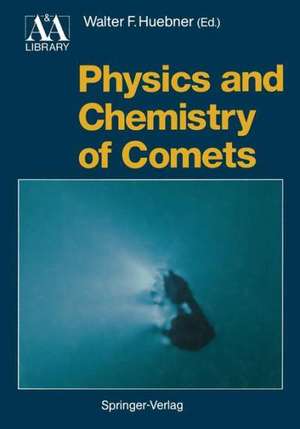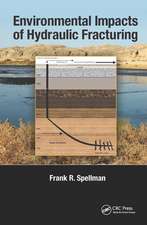Physics and Chemistry of Comets: Astronomy and Astrophysics Library
Editat de Walter F. Huebner Cuvânt înainte de Fred L. Whippleen Limba Engleză Paperback – 8 dec 2011
Din seria Astronomy and Astrophysics Library
- 17%
 Preț: 496.37 lei
Preț: 496.37 lei - 15%
 Preț: 603.58 lei
Preț: 603.58 lei - 19%
 Preț: 455.24 lei
Preț: 455.24 lei - 17%
 Preț: 525.72 lei
Preț: 525.72 lei - 13%
 Preț: 393.37 lei
Preț: 393.37 lei - 19%
 Preț: 524.14 lei
Preț: 524.14 lei - 17%
 Preț: 393.90 lei
Preț: 393.90 lei - 15%
 Preț: 647.40 lei
Preț: 647.40 lei - 15%
 Preț: 541.54 lei
Preț: 541.54 lei - 17%
 Preț: 362.70 lei
Preț: 362.70 lei - 18%
 Preț: 1006.55 lei
Preț: 1006.55 lei - 18%
 Preț: 745.33 lei
Preț: 745.33 lei - 15%
 Preț: 641.20 lei
Preț: 641.20 lei -
 Preț: 397.38 lei
Preț: 397.38 lei - 15%
 Preț: 598.21 lei
Preț: 598.21 lei - 15%
 Preț: 658.05 lei
Preț: 658.05 lei - 23%
 Preț: 815.07 lei
Preț: 815.07 lei -
 Preț: 409.89 lei
Preț: 409.89 lei - 15%
 Preț: 610.61 lei
Preț: 610.61 lei -
 Preț: 393.90 lei
Preț: 393.90 lei - 15%
 Preț: 655.27 lei
Preț: 655.27 lei - 18%
 Preț: 951.47 lei
Preț: 951.47 lei - 18%
 Preț: 960.42 lei
Preț: 960.42 lei - 18%
 Preț: 1397.68 lei
Preț: 1397.68 lei - 18%
 Preț: 959.98 lei
Preț: 959.98 lei - 18%
 Preț: 1012.08 lei
Preț: 1012.08 lei - 15%
 Preț: 481.03 lei
Preț: 481.03 lei - 15%
 Preț: 672.43 lei
Preț: 672.43 lei -
 Preț: 413.15 lei
Preț: 413.15 lei - 18%
 Preț: 1554.72 lei
Preț: 1554.72 lei - 18%
 Preț: 1410.63 lei
Preț: 1410.63 lei -
 Preț: 390.08 lei
Preț: 390.08 lei - 18%
 Preț: 944.99 lei
Preț: 944.99 lei - 19%
 Preț: 502.94 lei
Preț: 502.94 lei - 15%
 Preț: 654.12 lei
Preț: 654.12 lei - 24%
 Preț: 851.62 lei
Preț: 851.62 lei - 19%
 Preț: 515.32 lei
Preț: 515.32 lei - 15%
 Preț: 663.14 lei
Preț: 663.14 lei - 15%
 Preț: 656.43 lei
Preț: 656.43 lei - 18%
 Preț: 741.68 lei
Preț: 741.68 lei - 15%
 Preț: 647.40 lei
Preț: 647.40 lei -
 Preț: 388.90 lei
Preț: 388.90 lei - 18%
 Preț: 1217.72 lei
Preț: 1217.72 lei - 15%
 Preț: 651.51 lei
Preț: 651.51 lei - 15%
 Preț: 655.27 lei
Preț: 655.27 lei -
 Preț: 347.59 lei
Preț: 347.59 lei - 18%
 Preț: 794.39 lei
Preț: 794.39 lei
Preț: 397.01 lei
Nou
Puncte Express: 596
Preț estimativ în valută:
75.97€ • 79.54$ • 63.01£
75.97€ • 79.54$ • 63.01£
Carte tipărită la comandă
Livrare economică 09-23 aprilie
Preluare comenzi: 021 569.72.76
Specificații
ISBN-13: 9783642748073
ISBN-10: 3642748074
Pagini: 396
Ilustrații: XVI, 376 p.
Dimensiuni: 170 x 242 x 21 mm
Greutate: 0.63 kg
Ediția:Softcover reprint of the original 1st ed. 1990
Editura: Springer Berlin, Heidelberg
Colecția Springer
Seria Astronomy and Astrophysics Library
Locul publicării:Berlin, Heidelberg, Germany
ISBN-10: 3642748074
Pagini: 396
Ilustrații: XVI, 376 p.
Dimensiuni: 170 x 242 x 21 mm
Greutate: 0.63 kg
Ediția:Softcover reprint of the original 1st ed. 1990
Editura: Springer Berlin, Heidelberg
Colecția Springer
Seria Astronomy and Astrophysics Library
Locul publicării:Berlin, Heidelberg, Germany
Public țintă
ResearchCuprins
1. Introduction.- 1.1 Plan of the Book.- 1.2 General Concepts.- 1.3 Orbits of Some Comets for Spacecraft Missions.- 1.4 The Oort Cloud Compared to the Planetary Orbits.- 1.5 Summary of Spacecraft Data from Comets.- 1.6 Summary of New Data from Remote Sensing.- 1.7 Reasons for Planned and Proposed Comet Missions.- 1.8 Laboratory and Space Experiments and Simulations.- 2. The Nucleus.- 2.1 Introduction.- 2.2 Observational Techniques.- 2.3 Models of the Nucleus.- 2.4 The Nucleus of Comet P/Halley.- 2.5 Modeling and Laboratory Experiments.- 2.6 Physical Parameters of the Nucleus.- 2.7 Summary.- 3. The Neutral Coma.- 3.1 Introduction.- 3.2 The Coma: A Transient Phenomenon.- 3.3 Excitation and Emission Mechanisms.- 3.4 Composition of the Coma.- 3.5 Summary and Prospectus.- 4. Dust.- 4.1 Introduction.- 4.2 What is Comet Dust?.- 4.3 Dust Release from the Nucleus.- 4.4 Dust Emission.- 4.5 Dust Coma Structure.- 4.6 Dust Tails.- 4.7 Mass Distribution.- 4.8 Optical and Infrared Properties.- 4.9 Dust Composition.- 4.10 Dust Production Rate and the Dust to Gas Ratio.- 4.11 Summary.- 5. The Plasma.- 5.1 Introduction.- 5.2 Large-Scale Processes of the Solar Wind-Comet Interaction.- 5.3 Ion Composition.- 5.4 Ionospheric Processes.- 5.5 Plasma Wave Turbulence.- 5.6 Ion Acceleration.- 6. Orbital Distribution of Comets.- 6.1 Introduction.- 6.2 Origin and Dynamical Evolution.- 6.3 Time Scales.- 6.4 The Outer Part of the Presolar Nebula.- 6.5 The Distribution of the Reciprocal Semimajor Axes.- 6.6 Other Theories for the Origin and Evolution.- 6.7 Short-Period Comets.- 6.8 Differences Between Long- and Short-Period Comets.- 7. Comet Formation and Evolution.- 7.1 Introduction.- 7.2 Chemical and Physical Clues from Observations.- 7.3 Formation of Comet Nuclei.- 7.4 Dynamical Evolution of Comets.- 7.5 Physical Evolution of Comet Nuclei.- 7.6 Summary.- 8. Implications of Comet Research.- 8.1 Introduction.- 8.2 Progress in Physics and Chemistry of Comets.- 8.3 Progress on the History of the Early Solar System.- 8.4 Comets and the Origins of Life.- 8.5 Unsolved and New Problems.- References.














